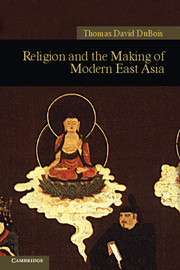Book contents
- Frontmatter
- Contents
- List of Boxes, Figures, and Maps
- Preface
- 1 In the beginning: Religion and history
- 2 Ming China: The fourteenth century's new world order
- 3 The Buddha and the shōgun in sixteenth-century Japan
- 4 Opportunities lost: The failure of Christianity, 1550–1750
- 5 Buddhism: Incarnations and reincarnations
- 6 Apocalypse now
- 7 Out of the twilight: Religion and the late nineteenth century
- 8 Into the abyss: Religion and the road to disaster during the early twentieth century
- 9 Brave new world: Religion in the reinvention of postwar Asia
- 10 The globalization of Asian religion
- Glossary
- Timeline of dynasties and major events
- Suggestions for further reading
- Index
4 - Opportunities lost: The failure of Christianity, 1550–1750
Published online by Cambridge University Press: 05 June 2012
- Frontmatter
- Contents
- List of Boxes, Figures, and Maps
- Preface
- 1 In the beginning: Religion and history
- 2 Ming China: The fourteenth century's new world order
- 3 The Buddha and the shōgun in sixteenth-century Japan
- 4 Opportunities lost: The failure of Christianity, 1550–1750
- 5 Buddhism: Incarnations and reincarnations
- 6 Apocalypse now
- 7 Out of the twilight: Religion and the late nineteenth century
- 8 Into the abyss: Religion and the road to disaster during the early twentieth century
- 9 Brave new world: Religion in the reinvention of postwar Asia
- 10 The globalization of Asian religion
- Glossary
- Timeline of dynasties and major events
- Suggestions for further reading
- Index
Summary
The Society of Jesus comes to Asia
Although separated by two and a half centuries, the early years of the Ming dynasty (1368–1644) and Tokugawa shogunate (1600–1868) present certain obvious similarities. Both regimes emerged from periods of chaos and warfare, and each one went to great lengths to transform society and thus establish a more durable political order. Bitter experience had taught the ambitious founders of each of these new governments that religion could be both a threat and an ally. Each enshrined new policies toward religion, supporting some, banning or ignoring others. Of course, the two were working within fairly different religious landscapes: the Ming emperor built up Confucianism but also faced the destabilizing influence of apocalyptic belief, while the early Tokugawa rulers had first to tame and then to harness Buddhist piety. To appreciate fully the comparison between these two, we need to see how each one reacted to the arrival of a new religion: Christianity.
The first Christian missionaries, Iberian Catholics of the Jesuit order, reached Japan in the mid-1500s, and China a few decades later. In each place, they found allies among the political elite and faced opposition from a variety of conservative figures, particularly Buddhist monks. Similarly, Christian missionaries in both Japan and China experienced an initial period of success, which was abruptly terminated by a sudden reversal of political fortune. By the early seventeen hundreds, Western missionaries had been expelled from both countries, and their religion banned by law.
- Type
- Chapter
- Information
- Religion and the Making of Modern East Asia , pp. 72 - 93Publisher: Cambridge University PressPrint publication year: 2011

